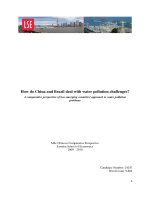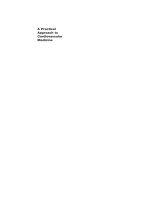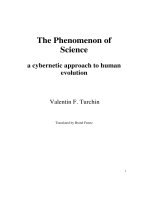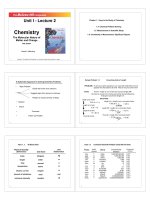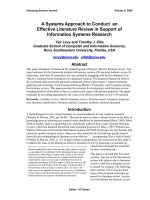a systematic approach to solving chemistry problems
Bạn đang xem bản rút gọn của tài liệu. Xem và tải ngay bản đầy đủ của tài liệu tại đây (1.23 MB, 5 trang )
Unit I - Lecture 2
Chemistry
The Molecular Nature of
Matter and Change
Fifth Edition
Martin S. Silberberg
Copyright ! The McGraw-Hill Companies, Inc. Permission required for reproduction or display.
1
1.4 Chemical Problem Solving
1.5 Measurement in Scientific Study
1.6 Uncertainty in Measurement: Significant Figures
Chapter 1 : Keys to the Study of Chemistry
2
A Systematic Approach to Solving Chemistry Problems
• State Problem
• Plan
Clarify the known and unknown.
Suggest steps from known to unknown.
Prepare a visual summary of steps.
• Solution
• Check
• Comment
• Follow-up Problem
3
Sample Problem 1.3 Converting Units of Length
PROBLEM: To wire your stereo equipment, you need 325 centimeters (cm) of
speaker wire that sells for $0.15/ft. What is the price of the wire?
PLAN: Known - length (in cm) of wire and cost per length ($/ft)
We have to convert cm to inches and inches to feet followed by
finding the cost for the length in ft.
SOLUTION:
length (cm) of wire
length (ft) of wire
length (in) of wire
Price ($) of wire
2.54 cm = 1 in
12 in = 1 ft
1 ft = $0.15
Length (in) = length (cm) x conversion factor
= 325 cm x
in
2.54 cm
= 128 in
Length (ft) = length (in) x conversion factor
= 128 in x
ft
12 in
= 10.7 ft
Price ($) = length (ft) x conversion factor
= 10.7 ft x
$0.15
ft
= $1.60
4
Table 1. 2 SI Base Units
Physical Quantity
(Dimension)
Unit Name
Unit
Abbreviation
mass
meter
kg
length
kilogram
m
time
second
s
temperature
kelvin
K
electric current ampere
A
amount of substance
mole
mol
luminous intensity candela
cd
5
Common Decimal Prefixes Used with SI Units
Table 1.3
6
Table 1.4 Common SI-English Equivalent Quantities
Quantity
SI to English Equivalent
English to SI Equivalent
Length
1 km = 0.6214 mile
1 m = 1.094 yard
1 m = 39.37 inches
1 cm = 0.3937 inch
1 mi = 1.609 km
1 yd = 0.9144 m
1 ft = 0.3048 m
1 in = 2.54 cm
Volume
1 cubic meter !m
3
" = 35.31 ft
3
1 dm
3
= 0.2642 gal
1 dm
3
= 1.057 qt
1 cm
3
= 0.03381 fluid ounce
1 ft
3
= 0.02832 m
3
1 gal = 3.785 dm
3
1 qt = 0.9464 dm
3
1 qt = 946.4 cm
3
1 fluid ounce = 29.57 cm
3
Mass
1 kg = 2.205 lb
1 g = 0.03527 ounce !oz"
1 lb = 0.4536 kg
1 oz = 28.35 g
7
Sample Problem 1.4 Converting Units of Volume
PROBLEM: When a small piece of galena, an ore of lead, is submerged in
the water of a graduated cylinder that originally reads 19.9 mL,
the volume increases to 24.5 mL. What is the volume of the
piece of galena in cm
3
and in L?
PLAN: The volume of galena is equal to the change in the water volume
before and after submerging the solid.
volume (mL) before and after addition
volume (mL) of galena
volume (cm
3
) of
galena
subtract
volume (L) of
galena
1 mL = 1 cm
3
1 mL = 10
-3
L
SOLUTION: (24.5 - 19.9) mL = volume of galena = 4.6 mL
4.6 mL x
mL
1 cm
3
= 4.6 cm
3
4.6 mL x
mL
10
-3
L
= 4.6x10
-3
L
8
Sample Problem 1.5 Converting Units of Mass
PROBLEM: What is the total mass (in kg) of a cable made of six strands of
optical fiber, each long enough to link New York and Paris
(8.84 x 10
3
km)? One strand of optical fiber used to traverse the
ocean floor weighs 1.19 x 10-3 lbs/m.
PLAN: The sequence of steps may vary but
essentially you have to find the length of the
entire cable and convert it to mass.
length (km) of fiber
mass (lb) of fiber
length (m) of fiber
1 km = 10
3
m
mass (kg) of cable
mass (lb) of cable
6 fibers = 1 cable
1 m = 1.19x10
-3
lb
SOLUTION:
8.84 x 10
3
km x
km
10
3
m
8.84 x 10
6
m x
m
1.19 x 10
-3
lbs
1.05 x 10
4
lb x
cable
6 fibers
= 1.05 x 10
4
lb
= 8.84 x 10
6
m
2.205 lb
1kg
x
6.30 x 10
4
lb
cable
=
6.30 x 10
4
lb
cable
=
2.86 x 10
4
kg
cable
2.205 lb = 1 kg
9
Figure 1. 10
A Length B Volume
Some interesting quantities.
C Mass
10
Substance Physical State Density (g/cm
3
)
Densities of Some Common Substances
*
Table 1.5
Hydrogen
Gas
0.0000899
Oxygen
Gas
0.00133
Grain alcohol
Liquid
0. 789
Water
Liquid
0.998
Table salt
Solid
2.16
Aluminum
Solid
2.70
Lead
Solid
11.3
Gold
Solid
19.3
*
At room temperature(20
0
C) and normal atmospheric pressure(1atm).
11
Sample Problem 1.6 Calculating Density from Mass and Length
PROBLEM: If a rectangular slab of Lithium (Li) weighs 1.49 x 10
3
mg and has
sides that measure 20.9 mm by 11.1 mm by 11.9 mm, what
is the density of Li in g/cm
3
?
PLAN:
Density is expressed in g/cm
3
so we need
the mass in grams and the volume in cm
3
.
mass (mg) of Li
lengths (mm) of sides
mass (g) of Li
density (g/cm
3
) of Li
10
3
mg = 1 g
10 mm = 1 cm
lengths (cm) of sides
volume (cm
3
)
multiply lengths
SOLUTION:
20.9 mm x
= 1.49 g
1.49x10
3
mg x
10 mm
1 cm
= 2.09 cm
Similarly the other sides will be 1.11
cm and 1.19 cm, respectively.
2.09 x 1.11 x 1.19 = 2.76 cm
3
density of Li =
1.49 g
2.76 cm
3
= 0.540 g/cm
3
1000 mg
1 g
divide mass by volume
12
Figure 1.11
Some interesting
temperatures.
13
Figure 1.12
The freezing and boiling points of water.
14
Temperature Scales and Interconversions
Kelvin ( K ) - The “Absolute temperature scale” begins at
absolute zero and only has positive values.
Celsius (
o
C ) - The temperature scale used by science, formally
called centigrade, most commonly used scale around the world;
water freezes at 0
o
C, and boils at 100
o
C.
Fahrenheit (
o
F ) - Commonly used scale in the U.S. for our
weather reports; water freezes at 32
o
F and boils at 212
o
F.
T (in K) = T (in
o
C) + 273.15
T (in
o
C) = T (in K) - 273.15
T (in
o
F) = 9/5 T (in
o
C) + 32
T (in
o
C) = [ T (in
o
F) - 32 ] 5/9
15
Sample Problem 1.7 Converting Units of Temperature
PROBLEM:
A child has a body temperature of 38.7
°
C.
PLAN:
We have to convert
°
C to
°
F to find out if the child has a fever and
we use the
°
C to Kelvin relationship to find the temperature in
Kelvin.
(a) If normal body temperature is 98.6
°
F, does the child have a fever?
(b) What is the child’s temperature in kelvins?
SOLUTION:
(a) Converting from
°
C to
°
F
9
5
(38.7
°
C) + 32 = 101.7
°
F
(b) Converting from
°
C to K 38.7
°
C + 273.15 = 311.8K
16
The number of significant figures in a measurement depends
upon the measuring device.
Figure 1.14A
32.3
°
C32.33
°
C
17
Rules for Determining Which Digits are Significant
All digits are significant
• Make sure that the measured quantity has a decimal point.
• Start at the left, move right until you reach the first nonzero digit.
• Count that digit and every digit to it’s right as significant.
Numbers such as 5300 L are assumed to only have 2 significant
figures. A terminal decimal point is often used to clarify the
situation, but scientific notation is the best!
except zeros that are used only to position the
decimal point.
Zeros that end a number and lie either after or before the decimal
point are significant; thus 1.030 ml has four significant figures, and
5300. L has four significant figures also.
18
Sample Problem 1.8 Determining the Number of Significant Figures
PROBLEM: For each of the following quantities, underline the zeros that are
significant figures (sf), and determine the number of significant
figures in each quantity. For (d) to (f), express each in
exponential notation first.
PLAN: Determine the number of sf by counting digits and paying attention to
the placement of zeros.
SOLUTION:
(b) 0.1044 g
(a) 0.0030 L (c) 53,069 mL
(e) 57,600. s
(d) 0.00004715 m
(f) 0.0000007160 cm
3
(b) 0.1044 g
(a) 0.0030 L (c) 53.069 mL
(e) 57,600. s
5.7600x10
4
s
(d) 0.00004715 m
4.715x10
-5
m
(f) 0.0000007160 cm
3
7.160x10
-7
cm
3
2sf 4sf 5sf
4sf
5sf
4sf
19
= 23.4225 cm
3
= 23 cm
3
9.2 cm x 6.8 cm x 0.3744 cm
1. For multiplication and division. The answer contains the same
number of significant figures as there are in the measurement
with the fewest significant figures.
Rules for Significant Figures in Calculations
Multiply the following numbers:
20
Rules for Significant Figures in Calculations
2. For addition and subtraction. The answer has the same
number of decimal places as there are in the measurement
with the fewest decimal places.
106.78 mL = 106.8 mL
Example: subtracting two volumes
863.0879 mL = 863.1 mL
865.9 mL
- 2.8121 mL
Example: adding two volumes 83.5 mL
+ 23.28 mL
21
Rules for Rounding Off Numbers
1. If the digit removed is more than 5, the preceding number
increases by 1.
5.379 rounds to 5.38 if three significant figures are retained
and to 5.4 if two significant figures are retained.
2. If the digit removed is less than 5, the preceding number is
unchanged.
0.2413 rounds to 0.241 if three significant figures are retained
and to 0.24 if two significant figures are retained.
3.If the digit removed is 5, the preceding number increases by
1 if it is odd and remains unchanged if it is even.
17.75 rounds to 17.8, but 17.65 rounds to 17.6.
If the 5 is followed only by zeros, rule 3 is followed; if the 5 is
followed by nonzeros, rule 1 is followed:
17.6500 rounds to 17.6, but 17.6513 rounds to 17.7
4. Be sure to carry two or more additional significant figures
through a multistep calculation and round off only the final
answer only.
22
Issues Concerning Significant Figures
graduated cylinder < buret ! pipet
numbers with no uncertainty
1000 mg = 1 g
60 min = 1 hr
These have as many significant digits as the calculation requires.
be sure to correlate with the problem
FIX function on some calculators
Electronic Calculators
Choice of Measuring Device
Exact Numbers
Figure 1.15
23
Sample Problem 1.8 Significant Figures and Rounding
PROBLEM: Perform the following calculations and round the answer to the
correct number of significant figures:
PLAN: In (a) we subtract before we divide; for (b) we are using an exact
number.
SOLUTION:
7.085 cm
16.3521 cm
2
- 1.448 cm
2
(a)
11.55 cm
3
4.80x10
4
mg
(b)
1 g
1000 mg
7.085 cm
16.3521 cm
2
- 1.448 cm
2
(a)
=
7.085 cm
14.904 cm
2
= 2.104 cm
11.55 cm
3
4.80x10
4
mg
(b)
1 g
1000 mg
=
48.0 g
11.55 cm
3
= 4.16 g/ cm
3
24
Precision and Accuracy
Errors in Scientific Measurements
Random Error -
In the absence of systematic error, some values that are higher and
some that are lower than the actual value.
Precision -
Refers to reproducibility or how close the measurements are to each
other.
Accuracy -
Refers to how close a measurement is to the real value.
Systematic error -
Values that are either all higher or all lower than the actual value.
25
Figure 1.16
precise and accurate
precise but not accurate
Precision and accuracy in the laboratory.
26
systematic error
random error
Precision and accuracy in the laboratory.
Figure 1.16
continued
27

